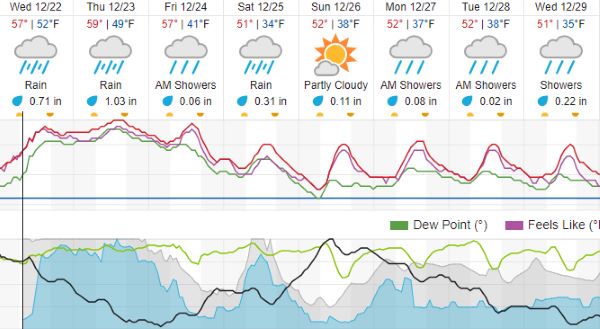Storm preparation tips for significant amounts of rain in the forecast
 City of San Luis Obispo shares storm preparation tips
City of San Luis Obispo shares storm preparation tips
– Tuesday was the first official day of winter and forecasters predict that it will rain several days this week and next week in San Luis Obispo County. Significant rainfall is in the forecast for Paso Robles, with the highest amount of precipitation accumulation expected on Thursday. The chance of rain goes well into next week: click here for a 10 day weather forecast for Paso Robles.
While widespread flooding with the coming rain isn’t expected, every winter brings with it potential flooding. To mark the first day of winter, and help the community prepare for storms and potential flooding, the City of San Luis Obispo offers these safety and preparedness tips to help the public get winter-weather ready:
- Know if you live in a flood zone (and if you do, purchase flood insurance). Do you know if you live in a flood zone? San Luis Obispo has various flood zones and you may live in one without even knowing it. View this interactive flood prep map to find out if you live in a flood zone. Flooding is often not covered by a standard homeowner’s insurance policy. A separate flood insurance policy is required to cover damages incurred by flooding. Anyone can carry flood insurance; it is not limited to those properties in designated flood zones. Coverage is available for the building itself as well as for the contents of the building. The City of San Luis Obispo participates in the National Flood Insurance Program (NFIP) that makes available federally backed flood insurance for all structures, whether they are located within the floodplain. Note that there is a 30-day waiting period before coverage goes into effect. More than 25% of NFIP claims are filed by properties located outside the 100-year floodplain, also known as the Special Flood Hazard Area (SFHA). Please contact your insurance agency for more information.
- Protect your property from the hazards of flooding. Doing your part at home and in your neighborhood can help prevent property damage due to flooding. Help reduce flooding in the event of heavy rains by maintaining the drainage channels in your neighborhood or reporting any obstructions to the city. At home, consider placing sandbags in areas where water can flow into living spaces.
- Have sufficient supplies for yourself and your pets to last for several days. Non-perishable food, water, batteries, flashlights, a manual can opener, and a battery-operated radio should be kept available. Pick up any prescription medication you may need before the storm hits. Charge your electronic devices and check your flashlight and radio batteries.
- Change your vehicle’s windshield wipers and drive even more carefully when it rains. Before it starts to rain, replace old or brittle wiper blades to maintain visibility while driving in the rain. When driving in the rain, slow down and be more alert for brake lights in front of you. Never drive through moving water if you can’t see the ground through it; your vehicle could be swept off the road. And never use cruise control on wet roads or icy road conditions as cruise control can cause skidding and loss of tire traction on wet or icy roads. For more tips on how to drive in the rain, visit the California Office of Traffic Safety’s Common Sense Safety Tips for Winter Travel. Please report any malfunctioning traffic signals or streetlights to lights@slocity.org.
- Be aware of changing conditions and monitor your local media for weather alerts and updates. The National Weather Service issues flood alerts using specific terms. The terms below tell you what action, if any, you should take:
- Flood Advisory: Be aware. Keep an eye out for changing weather conditions. Flood Advisories are issued when a specific forecasted weather event may become a nuisance. Flooding should not be bad enough to issue a Flood Warning.
- Flood Watch: Be prepared. Keep an eye out for flooding and be prepared to move away from the area. A Flood Watch is issued when conditions are favorable for a hazardous weather event to occur. Conditions are favorable for flooding.
- Flood Warning: Take action! If you are in a flood prone area, move away. Flood Warnings are issued when the weather event or flooding is about to occur or is already occurring.
- Flash Flood Warning: Take action! If you are in a flood prone area, move to high ground at once. A Flash Flood Warning is issued when a flash flood is about to occur or is already occurring. A flash flood is a sudden violent flood that can take minutes to hours to develop.
For more tips or frequently asked questions about winter weather preparedness, visit www.GetReadySLO.com.


 City of San Luis Obispo shares storm preparation tips
City of San Luis Obispo shares storm preparation tips


















